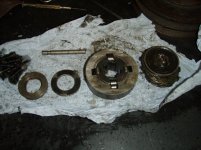gary350
Hot Rolled
- Joined
- Aug 11, 2008
- Location
- Murfreesboro, TN. USA
I have a 12 x 36 Churchhill lathe from England. The clutch has been slipping for a long time after it runs and gets hot it ususlly does fine all day but today it will not run. I took it apart and the clutch has a disc type brake pad covered in oil and black grease. I don't know if it is suppose to be covered in oil or if that is leakage from many years of use. I'm not sure what to do at this point. Should I degrease the clutch disc plate and put it back together and see what happens? It has 3 springs and about 15 balls inside I will have to stick the balls in place with some thick grease to hold them there to get it back together. I don't know any other way to hold the balls in place while I put it back together unless rotate the whole lathe 90 degrees and stand the lathe up on end. Once it is together maybe some degreaser spray can be used to remove the grease. Maybe it needs a little grease I don't???
Anyone here have any ideas???
The clutch plate might need to be replaced, what on earth can I do about that, I bet no such thing is available anymore???
Anyone here have any ideas???
The clutch plate might need to be replaced, what on earth can I do about that, I bet no such thing is available anymore???
Last edited:








